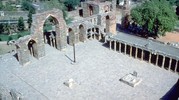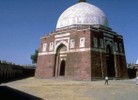Previous Lecture | Next Lecture
Concepts
Muslim Dynasties in Delhi
- The Mamluk kings of Delhi (1193-1290)
- The Khaljis of Delhi (1290-1320)
- The Tughluqid Dynasty of Delhi (1320-1414)
Muslim Dynasties in the Provinces
- The Sharqi Sultans at Jaunpur (1394-1479)
- The Bahmanid Sultanate at Gulbarga (1347-1527)
Trabeate Architecture: The characteristic architectural principle of Hindu India based on the post-and-lintel system, mostly done in stone, and related stylistically and decoratively to carved wood architecture.
Arcuate Architecture: The contrasting architectural principle based mostly on vaults, arches, and domes, executed in brick. It is generally attributed to Mesopotamia and Persia, and seen as the Islamic style brought to India with the invading Turkish armies.
Monuments
The Minaret of Jam, Afghanistan
(1163-1203). This cylindrical, heavily-ornamented, 65-meter high brick tower is the most remarkable of a group of little-understood towers/minarets spread all over the medieval Turko-Iranian regions from Iraq to India.
The Mosque of Quwwat al-Islam (Might of Islam)
(1193-99, 1220-29, and 1316). Delhi's earliest congregational mosque started by Aybak, the first Mamluk sultan of Delhi. It shows the conflict between the Hindu building tradition and the architectural requirements of mosques. It was enlarged twice.
The Qutb Minar of Quwwat al-Islam Mosque
(1199). Built by Aybak as a victory tower. It echoes the minaret of Jam, built by his master Ghiyath al-Din Muhammad of Ghur, but rises 7 meters higher.
The Ala'i Darwaza at Quwwat-al-Islam Mosque
(1311-16). The remaining gate of the expansion intended by Sultan Khalji. It shows the mastering of Islamic stone tradition by Indian masons and/or the influence of Seljuk immigrants.
The Congregational Mosque at Jaunpur
(1394-1479). This mosque is influenced by Tughluqid forms, but its screen in the qibla façade is transformed into a huge propylon.
The Tomb of Ghiyath al-Din Tughluq at Delhi-Tughluqabad
(1325). Built in a fort in an artificial lake, this mausoleum is made of a red sandstone cube, with heavily slanted sides, and a white marble dome on top.
The Tomb of Iltutmish at Delhi behind the Quwwat al-Islam
(1210-35). Though using Hindu building techniques, this mausoleum is rooted, functionally and symbolically, in the Islamic tradition. Its Islamic character is formally expressed in the dome resting on squinches, mihrab, and Qur'anic inscriptions.
The Congregational Mosque at Gulbarga in the Deccan
(1367). Built by the Bahmanid Muhammad I, this mosque is totally covered. The vaults, domes, and arches in the façades indicate a strong Persian influence.







